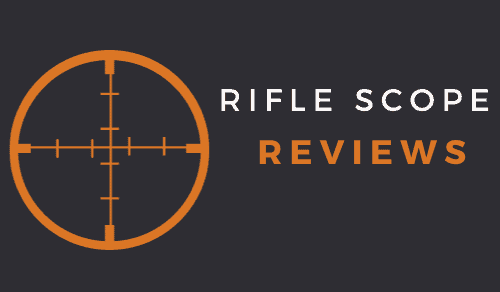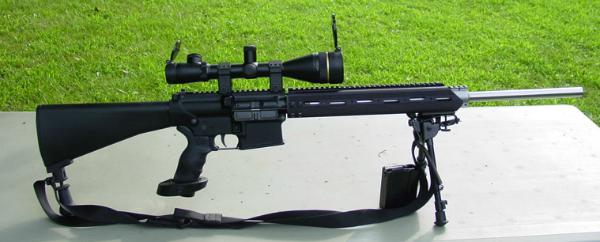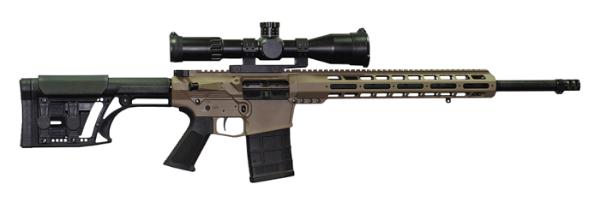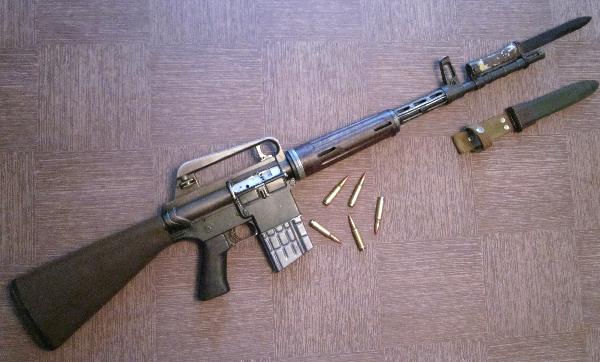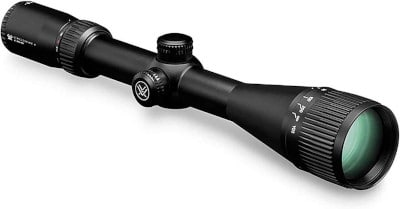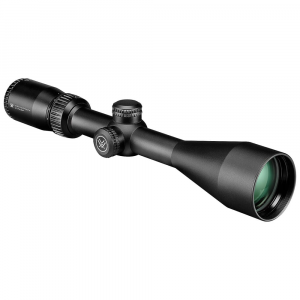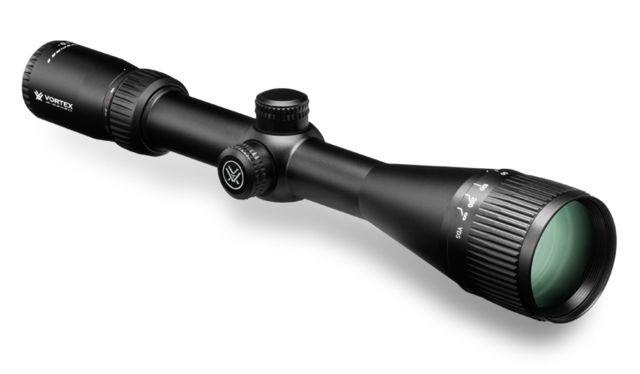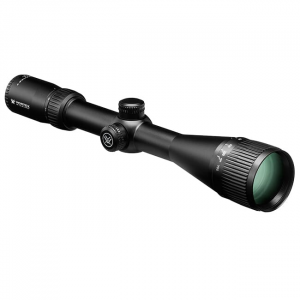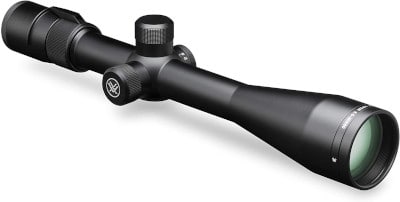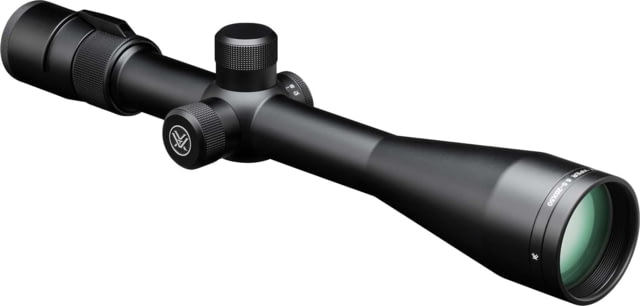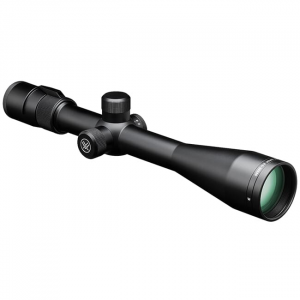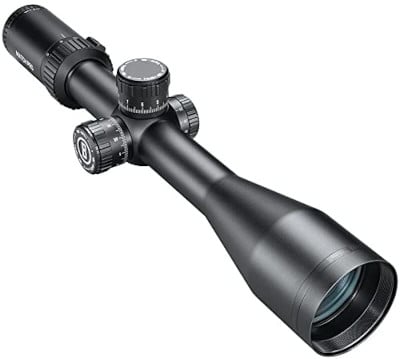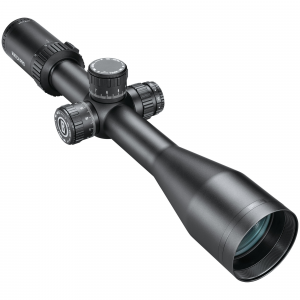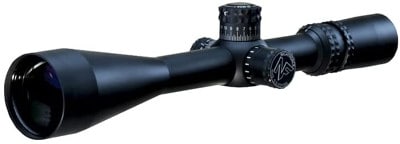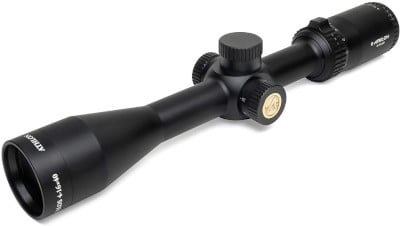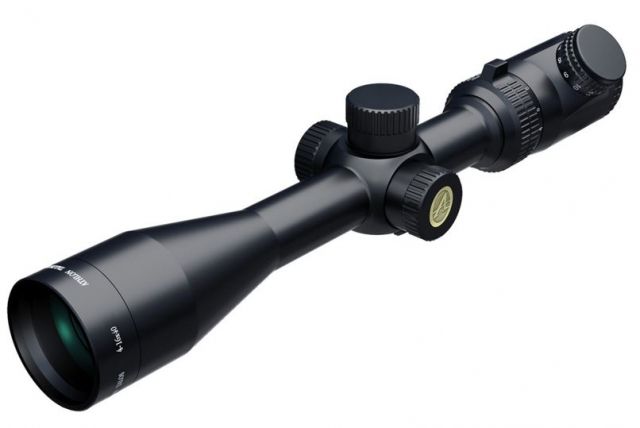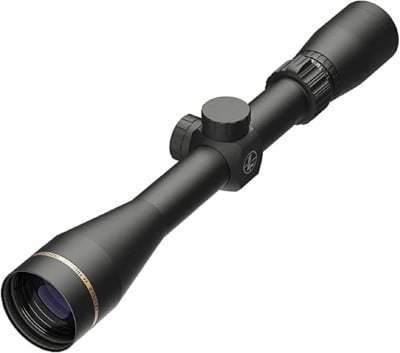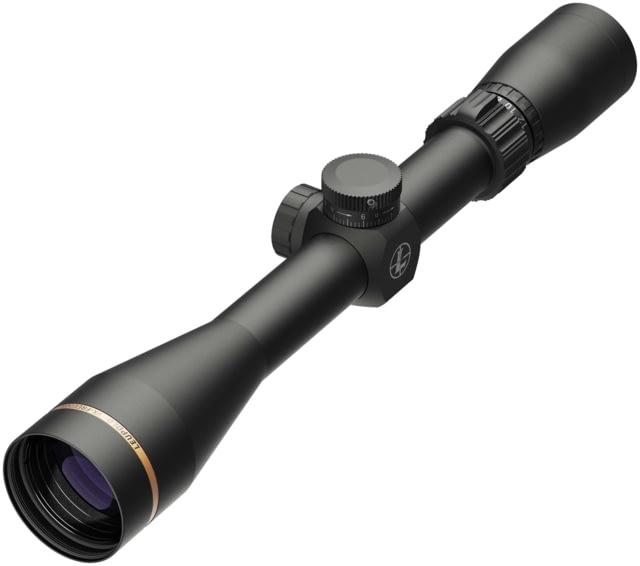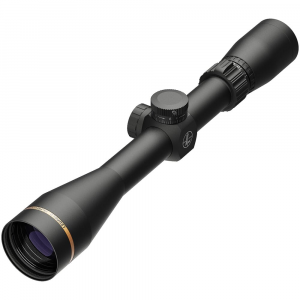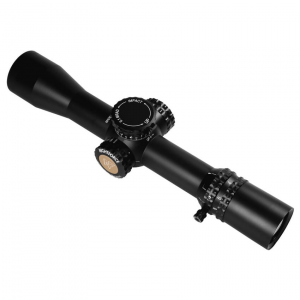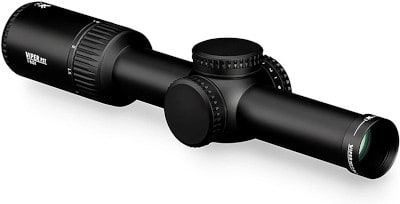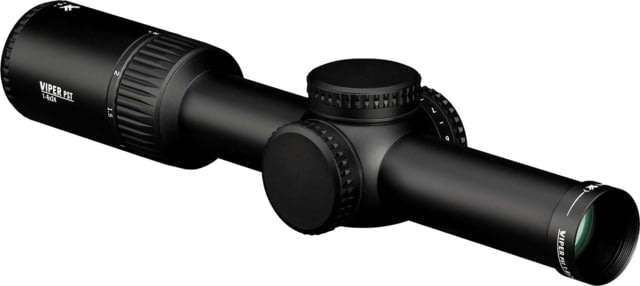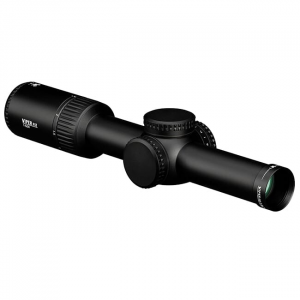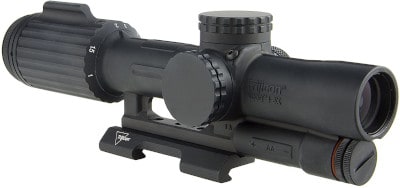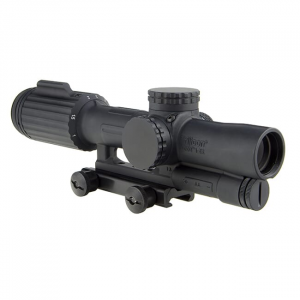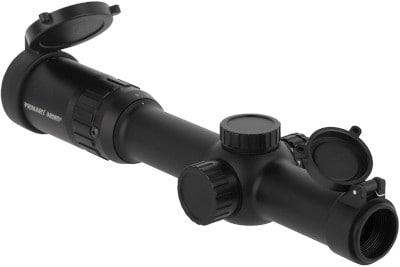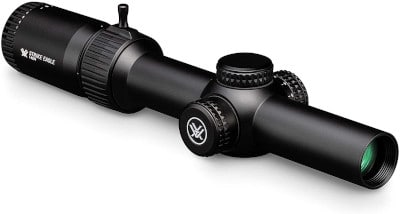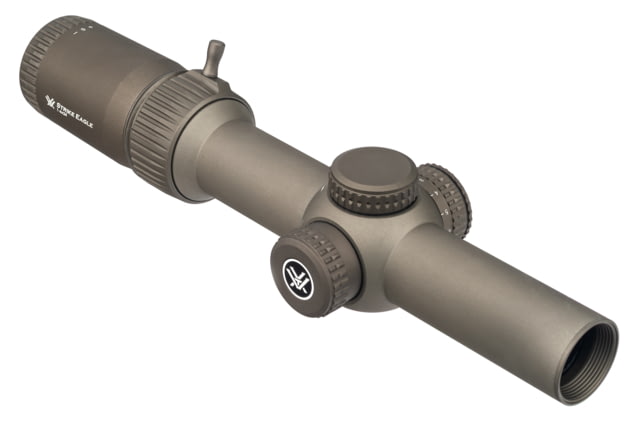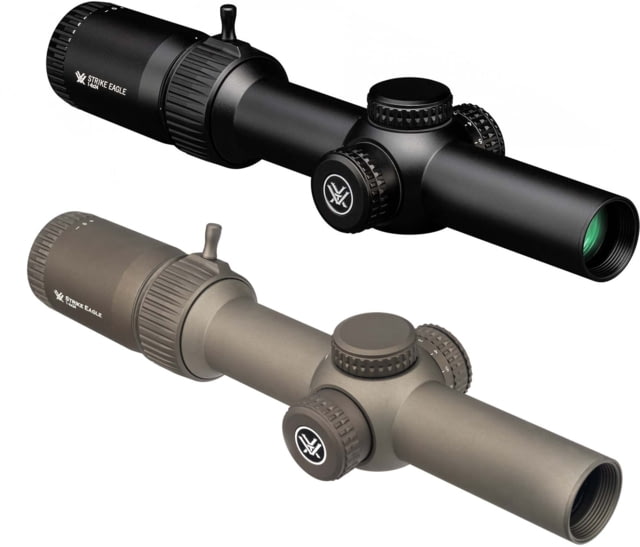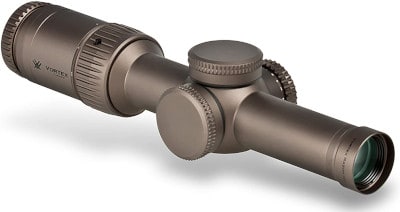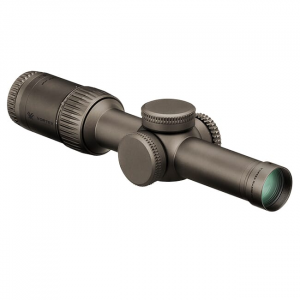As an Amazon Associate I earn from qualifying purchases. Amazon and the Amazon logo are trademarks of Amazon.com, Inc, or its affiliates.
When you start shopping for a scope to go on an AR-10 rifle, there are several variables to consider before making a decision. The AR 10 rifle is a highly versatile platform that can be used for several different purposes, and this versatility is part of the AR 10 appeal. So, before taking a deep dive into the topic of the best scope for a AR 10 rifle, let’s go over a few essential aspects of the AR 10 platform itself.
In a Hurry to See the Scope Recommendations?
AR 10 History
The Armalite AR-10 is more commonly known as an AR10 or AR 10 and is very similar in design and style to its more famous cousin, the AR-15 rifle. Most people think that the AR 10 is based on the AR-15 design, but the truth is the other way around.
The AR 10 platform was designed by a gentleman named Eugene Stoner in 1955 and introduced to the military market in 1957. Initially chambered in a NATO 7.62X51, the AR 10 was designed as a military-based battle rifle that weighed less than most other military rifles of that time period and would/could be fired as fully automatic. However, the original Armalite AR-10 didn’t really catch on, and it’s estimated that Armalite manufactured less than 10,000 of the AR10 models.
In 1957, Armalite changed the AR-10 design a bit and built a version chambered in the .223 Remington caliber. The smaller, lighter model chambered in .223 was called the AR-15.
In 1959, Armalite encountered some financial issues and sold the rights to the AR-10 and the AR-15 over to Colt Firearms. Colt made a few modifications and pitched their version of the AR-15 to the U.S. military as the M16 rifle. Colt also began offering a civilian version of the AR-15, which they called the Colt AR-15, to the civilian market.
Once Colt’s original patent in the AR-10 model expired, several firearm brands started producing rifles based on the AR-10 platform. While the original AR-10 models were piston-driven, many current models on the market are 100% gas-driven.
AR-10 Calibers
Initially, the AR 10 rifles were built in a 7.62X51mm NATO caliber, which is very close to the U.S.-based .308 caliber. So close that an AR-10 chambered in 7.62X51mm can fire the .308 cartridges.
As the AR 10 grew in popularity, firearm makers started either building or converting the AR-10 platform to other calibers, including some .20 caliber variants and several .30 caliber variants such as:
- .220 Swift – Billed as the fastest commercial cartridge in the world, the .220 Swift lives up to its name with a maximum known velocity of 4,665 feet per second. Designed for small vermin and pests at distances over 200 yards.
- .22-250 Remington – Another fast-moving caliber designed for shooting and hunting vermin and pests at longer ranges.
- .243 Winchester – A popular big caliber, especially for whitetail deer.
- .257 Roberts – Named after Ned Roberts, the .257 Roberts is a .25 caliber round that can take anything but the largest game in North America.
- .260 Remington – For hunters, the .260 Remington is an excellent option above the .243 but below the7mm-08. The .260 is very recoil-friendly, so it’s a good choice in the lightweight AR-10 platform.
- .308 Winchester – A staple long-distance round popular for hunting (replacing the venerable 30-06), long-range shooting, and military or law enforcement snipers.
- .338 Federal – This is another caliber in the AR-10 platform capable of taking any game in North America and Canada. It’s a hard-hitting long-distance caliber that doesn’t punish the shooter recoil-wise.
- .358 Winchester – While not as popular as the .338 Federal, the .358 Winchester is another hard-hitting big game that, with the right load, can handle almost any game in North America.
- 6mm Remington
- 6mm Creedmoor
- 6.5 Creedmoor – One of the most popular long-range calibers, but also suitable for certain hunting situations
- 7mm-08 Remington – Another very popular hunting caliber capable of taking most any game in North America with the right load and features very manageable recoil.
- .500 Auto Max – A relative newcomer to the AR-10 platform, the .500 Auto Max is a big bore cartridge designed to handle big game, including the true big game animals found on the African continent. If you want to hunt buffalo or elephants with an AR-10 style rifle, then the .500 Auto Max might be one of your only options.
In addition to the calibers that are commonly seen in the AR-10 platform, there are a few other available calibers. While the calibers below can be configured in an AR-10, with the changes made to accommodate something specific about the caliber. Those “wildcat” AR-10 variant calibers are:
- .25-06
- .30-06
- .300 Win Mag
- .338 Lapua Magnum
- .458 Winchester Magnum
How is the AR-10 Being Used?
Another factor to consider when shopping for the best AR-10 scope for you focuses on what type of shooting or hunting will you be doing? Typically, with an AR 10, there are three main areas of shooting where it shines:
Long Range Shooting
As some of the AR 10 calibers are considered excellent candidates for long-range or long-distance shooting, it stands to reason that the AR-10 in certain calibers would be a popular platform for this type of shooting. The most popular AR-10 calibers for long-range shooting seem to be the .308 and the 6.5 Creedmoor.
Hunting
Most any caliber from the list above would be a good choice for a hunting rifle. Obviously, the caliber plays a role in determining what type of hunting and what species to be hunted. While the AR-style rifles are not as popular in a hunting scenario as the more traditional types of hunting rifles, the AR platform is gaining popularity as a hunting rifle. Some brands, such as Remington, are even producing AR-style rifles geared specifically for hunting predators, wild pigs, and whitetail deer.
Even with most states having a magazine capacity limit of 10 rounds for hunting, the AR-10 style platform of rifles offers the benefit of quicker follow-up shots (if needed) coupled with pinpoint accuracy from match-grade AR barrels.
Home Defense
While the AR-10 isn’t the first choice that comes to mind for a home defense rifle, the AR-based platforms certainly have their place in a home defense discussion.
The AR-10 platform can be an especially effective option for those having to defend large tracts of land such as a farm or situations where home defense may include protecting oneself from large predators. In those situations, the larger calibers found on the AR-10 are a better option than the smaller .20 caliber rounds found in the smaller AR-15 platform. The AR10 platform also functions well as a 308 shft 0ption if such a situation arose.
Truck Rifle or Ranch Rifle
The AR-10 is a popular option as a utility-based truck or ranch rifle that might be needed to perform several functions, including self-defense, home defense, predator control, and hunting as required.
Typical Shooting Distances or Ranges for the AR-10
Another factor to consider when riflescope shopping for a AR 10 includes the typical ranges (as in distances) that you’ll be shooting. Typically, the ranges are loosely grouped into three categories:
400 yards and Beyond
Shots at these ranges are considered longer-range shots, and several of the more popular AR 10 calibers are ideal for accurate shots out to 1000 yards and beyond. Typically, long range shooting is very precision-oriented and involves smaller targets. The longer distances combined with, the smaller targets require an optic with greater clarity and something on the higher end of magnification power.
In terms of a magnification range, I recommend something that is a minimum of 12X power. Scopes designed for long-range type shooting will need to have a relatively large objective bell to let in as much light as possible, so I suggest a model with a bell diameter of at least 44mm or more. The reticle choice will be important because a thick reticle can easily obscure a tiny target at those distances.
200 to 400 Yards
Shots in those distances are commonly called mid-range shots or middle-range shots, and the AR-10 in most any caliber performs very well at those distances. Targets in the 200-400 yard range will be best suited for a riflescope with a moderate range of magnification power. I’d suggest something in the 4-12 or 4-16 magnification range. Keep in mind that most higher-powered rifle scopes will work equally well in the 200 to 400-yard range. The reticle options will also be more open as those distances require a less precise reticle.
Now, are you required to have a 4-12 scope to shoot in the 200 to 400-yard range? No, not really. I’ve seen shooters make solid hits at those ranges with lower-powered scopes or even battle-type scopes in the 2-8 or 2-6 magnification range. However, a higher-powered 4-16 or 4-12 scope model offers an advantage when you get out to the 350 to 400-yard shots.
0 to 200 Yards
Shots in the 0-200 yard range are considered short-range shots, and a lower-powered optic on the 1-8 or 2-6 power range is optimal for that type of shooting. However, if the AR 10 is specifically geared for self-defense or home defense at those ranges, you could also opt for a battle or combat optic with a power range as low as 1X to 4x.
AR 10 Optics
At my day job, I routinely field questions asking about the best scope for 308 rifles, or the best AR 10 scope. Unfortunately, it’s difficult to recommend a single optic that I can comfortably name as the best AR10 scope without having some additional information about how the rifle will be used.
As you can see, there are many variables to be taken into consideration for choosing an AR10 scope, and given their mission-specific uses, it makes sense to offer optic suggestions that are more geared toward how you plan to use your AR-10. So, let’s look at scope recommendations based on the desired usage:
Long Range AR-10 Scope Recommendations
Brand & Model | Image | Tube Size | Focal Plane | Reticle Options | Shop |
Vortex Crossfire II 6-24x50 | 30mm | Second Focal Plane | Dead-Hold BDC V-Plex | ||
Vortex Viper PA 6.5-20x50 | 30mm | Second Focal Plane | Dead-Hold BDC Mil-Dot | ||
Sightron SIII 6-25x50 | 30mm | Second Focal Plane | MOA-2 Mil-Dot | ||
Bushnell Match Pro 6-25x50 | 30mm | First Focal Plane | Deploy MOA | ||
Nightforce NXS 5.5-22x56 | 30mm | Second Focal Plane | MOAR |
Here’s a more in-depth look at each of those long range scope suggestions, including specifications, performance ratings, and pros and cons.
Vortex Crossfire II 6-24-50 Dead-Hold BDC
![]() Although the Crossfire II series of scopes is more considered an entry-level scope within the Vortex Optics line of riflescopes, don’t let that fool you, as the Crossfire II is one of the most well-made and feature-rich scopes you’ll see at this price point. This model features a 30mm tube manufactured from aircraft grade aluminum with a 50mm objective lens to draw in as much light as possible. While the glass quality isn’t the absolute best I’ve ever seen, it’s very good for a scope in this price range.
Although the Crossfire II series of scopes is more considered an entry-level scope within the Vortex Optics line of riflescopes, don’t let that fool you, as the Crossfire II is one of the most well-made and feature-rich scopes you’ll see at this price point. This model features a 30mm tube manufactured from aircraft grade aluminum with a 50mm objective lens to draw in as much light as possible. While the glass quality isn’t the absolute best I’ve ever seen, it’s very good for a scope in this price range.
The DeadHold BDC reticle can be calibrated to work with almost every caliber that the AR-10 comes in and functions well for long range shooting. If you don’t like the BDC reticle, Vortex also offers this scope model in a version with their V-Plex reticle (more like a standard Duplex), and it can be seen here.
One big plus on this Crossfire II scope model is that the parallax goes down to 10 yards, making this scope usable at both long and shorter ranges and most big game hunting applications. Also, the construction on the Crossfire II is sturdy enough for it to hold up against the repeated recoil of the powerful .30 round calibers commonly seen on an AR-10.
| Pros | Cons |
| Parallax goes down to 10 yards.
Built-in fast-focus eyepiece. Capped turrets, so the elevation and windage adjustments are protected. It comes with a sunshade and lens covers. It comes with Vortex’s excellent forever warranty | The parallax adjustment is on the objective, so a lens cap or cover might interfere with the ability to adjust the parallax.
It weighs 23.6 ounces which isn’t all that heavy but isn’t the lightest scope in this class either. The Dead-Hold BDC requires some testing to find the optimal load for accurate BDC (Bullet Drop Compensation), which requires some range time. |
If you’re shopping for an all around best scope for an AR 10, then this Crossfire II model is worth a second look. Here are a few locations online that have this Crossfire II scope at very reasonable pricing:
Vortex Optics Viper PA 6.5-20×50 Mil-Dot Riflescope

The Viper PA series is a step up above the previously discussed Crossfire II series and the Diamondback Tactical series within the Vortex line of scopes. Built on a 30mm tube with a 50mm objective lens, the Viper PA model also comes in either a traditional Mil-dot reticle or a Dead-Hold BDC reticle (which can be seen here). While both reticles have their own set of pros and cons, my personal preference is the mildot reticle.
The Viper PA is built like a tank to withstand some heavy-duty usage and features some pretty good multi coated glass at a very reasonable cost. I’d rate the glass on the Viper PA above the glass on the Vortex Crossfire II, but that’s to be expected as the Viper PA scope has a higher cost.
In addition to better glass, the Viper PA comes with a side focus for the parallax adjustment, which is easier to access (at least in my opinion) than having the parallax adjustment on the objective.
The one thing I’m not crazy about with the Viper PA is the fact that the parallax will only adjust down to 50 yards. That feature makes this scope model a better choice for longer distance shots, as any shot taken under 50 yards may have a slightly blurry sight picture.
| Pros | Cons |
| Good (but not great) fully multi coated glass
It comes with the Vortex Lifetime Warranty Side focus parallax adjustment Capped turrets for turret protection Good field of view for this power range 21.6 ounces in weight, making it very light for a scope this size. Has the capacity for custom turrets through Kenton Industries | The parallax bottoms out at 50 yards, so it may not work for short-range shots.
It doesn’t come with a sunshade, but one can be purchased separately. A minor nit-pick but one of my pet peeves. Although the reticle is either BDC or Mil-dots, the turrets are MOA-based, which might be confusing for some not familiar with MOA-based reticles. The eye relief is 3.1 inches which is a bit on the short end for a higher recoiling caliber. |
If this Vortex scope interests you, here are a few places i found it for sale:
Sightron SIII Long Range 6-24X50 with MOA-2 reticle

The Sightron SIII series of scopes isn’t exactly Sightron’s top-of-the-line scope series, but it’s pretty darn close to the top of the line. The SIII models are built on a robust 30mm single-piece tube using higher-end Japanese multi coated glass. In addition, while some of the Sightron scope models are made in the Philippines, the SIII models are manufactured in Japan.
One of Sightron’s strengths in the sporting optics industry is its glass quality and reticle options. This particular SIII 6-24×50 model is only available in two different reticle options:
- MOA-2 reticle (Sightron Model 25127)
- MilDot reticle (Sightron Model 25133)
In addition to the reticle options listed above, Sightron has previously offered this scope configuration in the following reticle choices as well:
- MOA-2 reticle (Sightron Model 25127)
- Illuminated MOA-2 reticle
- MOA-H reticle (Sightron Model 25012)
- Illuminated MOA-H reticle (Sightron Model 25013)
- MilDot reticle (Sightron Model 25133)
- .25 Dot reticle
- Narrow Duplex reticle
- Wide Duplex reticle
These reticle choices have been slowly phased out over time, but you still may be able to find one of the reticle options listed above on the market.
For the purposes of this write-up, I’m going to suggest the MOA-2 reticle as I think it offers the most flexibility for an AR-10 platform.
Note that Sightron also offers a version of this scope series in a first focal plane version and a second focal plane variant that has is equipped with a zero stop feature.
The SIII 6-24X50 with MOA-2 reticle (Sightron Model 25127) features capped turrets that equate to ¼” at 100 yards. The turret adjustments are substantial feeling with both an audible and tactile click when adjustments are made.
Although glass quality is always a subjective topic, in my eyes, the multi coated glass on the SIII is a noticeable jump in quality over the prior Vortex scopes mentioned, but that makes sense as this SIII is also a significant jump in price as well.
My single biggest complaint with this SIII model is that the side focus bottoms out at 40 yards, making a close-range shot difficult. I have this exact model mounted on a 17HMR for longer-range squirrel and ground squirrel hunting, and it performs exceptionally well. Now, this scope isn’t cheap, but you get a lot of scope for what you pay.
| Pros | Cons |
| Excellent glass for the money with a crisp and clear image.
Better than average field of view. Capped turrets for turret protection. Comes with a sunshade and accessories. A very durable scope that seems to hold zero regardless of caliber and recoil. Comes in a wide range of reticle choices compared to other brands in this space. | Side focus bottoms out at 40 yards, so if you encounter a close-in shot while hunting, the target might be blurry and out of focus.
Not cheap, but not overly expensive either. It uses a MilDot reticle combined with MOA turrets which can be confusing if you prefer a MIL/MIL or MOA/MOA set-up. |
Here’s a few places that have this scope available at very reasonable prices:
Bushnell Match Pro 6-24×50 FFP with Deploy Mil Etched Reticle
Bushnell markets the Match Pro 6-24×50 scope as being designed as a competition scope, but that’s shortchanging the true potential of this model. In addition to being at home in a competition setting, the Match Pro scope is equally at home as a mid-range and long-range AR-10 scope.
The Match Pro scope is an FFP model built on a 30mm tube, and the optical quality is extremely good for the money. It’s rated for centerfire recoil and holds up well to any of the more common AR 10 calibers.
One of the things I like about this model is the level of built-in parallax adjustments. This versatile scope features a side focus parallax adjustment that focuses all the way down to 10 yards, making it adaptable enough for long-range, short-range, and most any hunting scenario that you may come across.
The FFP reticle configuration means that the reticle changes in size as the power signification increases, which keeps the holdovers the same at any magnification setting.
While the turrets are exposed, they will lock, and the scope is equipped with a tool-less zero reset function. This scope is available in two versions:
- An illuminated version (Model MP6245BF8)
- Non-illuminated version (Model MP6245BF2)
| Pros | Cons |
| Although very solidly built, this scope is surprisingly lightweight.
Side focus adjusts down to 10 yards making it highly versatile. Nitrogen purged for fog proof optics. Better than glass for the money with excellent clarity throughout the entire power range. Locking turrets with tool-less zero reset. | It is marketed as a competition scope but performs well as a dedicated long-range scope on an AR platform.
It comes with Bushnell’s Limited Lifetime warranty which isn’t the same thing as a straight forever warranty like you see with other brands. The FFP functionality takes some getting used to and may not be for everyone. |
If you’re interested in this Bushnell scope, here are a few places it’s available for sale:
Nightforce 5.5-22X56 NXS with Mildot Reticle
![]() If the Leupold brand of scopes is the best-known U.S.-based brand of hunting scope options, then Nightforce is the top U.S.-based brand of long-range optics. The Nightforce 5.5-22X56 NXS is an excellent option for an AR-10 shooter who is serious about their long-range gear.
If the Leupold brand of scopes is the best-known U.S.-based brand of hunting scope options, then Nightforce is the top U.S.-based brand of long-range optics. The Nightforce 5.5-22X56 NXS is an excellent option for an AR-10 shooter who is serious about their long-range gear.
All the Nightforce models are built for rugged use and durability, but it comes at a price in weight as this scope weighs in at a hefty 32 ounces, which is almost 8 ounces more than most of the other scopes on this list.
The glass on the NXS is top shelf and easily rivals the glass you will see in a top-tier European brand like Zeiss or Kahles. In addition, this model offers outstanding clarity and color throughout the entire power range, as you would expect from the costs.
The Nightforce NXS 5.5-22X56 is available with several different reticle options, but my favorite is the MD reticle (in case you haven’t noticed a pattern here, I’m usually a fan of mil-dots as they are easy to configure and work well for most any shooting application).
Now, the NXS that I’ve mentioned here is not cheap, but, sometimes with optics, you really do get what you pay for as Nightforce scopes are built to last a lifetime.
Another thing to mention about Nightforce is they appear to have a great warranty program. While I haven’t personally had to send any of mine in for service, I know of someone who did.
I had a buddy who purchased a used Nightforce Varminter model (which is/was an older model that Nightforce no longer offers) off of a forum. After about 200 rounds, he noticed that the scope didn’t appear to be holding zero. So he called Nightforce customer support, and they had him send the scope in a call tag. A week later, a Nightforce customer service person called him saying that they couldn’t fix the issue, so they are sending him a new model in the same power range with the same reticle. It’s hard to argue with a company that completely replaces a used $1000 scope with a new one worth $1900.
My single biggest complaint on this model of the NXS is that the side focus only adjusts down to a minimum of 50 yards, making this model a dedicated long-distance scope.
| Pros | Cons |
| Great glass quality with excellent light transmission.
Built like a Sherman tank Mil-Dot reticle with matching mil-based turrets. A broad power range that would work well for both long-range and mid-range shooting. Outstanding Nightforce warranty | This scope is on the heavier side for this power range, so it may not be the best option if you’re looking for a lightweight AR-10 set-up.
Side focus bottoms out at 50 yards, so any shot taken at a target at or under that distance may be out of focus. Not exactly friendly on the wallet, but worth the money. |
If your idea of the best scope for AR -10 involves long range shooting, then this particular Nightforce scope could be the ticket for you. If this Nightforce riflescope interests you, here are a few places that it’s listed for sale at reasonable prices:
Mid-Range AR-10 Scope Recommendations
Brand & Model | Image | Tube Size | Focal Plane | Reticle Options | Shop |
Primary Arms SLx 4-14x44 | 30mm | First Focal Plane | ACSS HUD-DMR 308 | ||
Athlon Talos 4-16x40 | 1 inch | Second Focal Plane | BDC 600 IR Mil-Dot | ||
Leupold VX-Freedom 4-12x40 | 1 Inch | Second Focal Plane | Tri-MOA CDS | ||
Sightron S-TAC 4-20x50 | 30mm | Second Focal Plane | MOA-2 | ||
Nightforce NXS 5.5-22x56 | 34mm | First Focal Plane | MOAR |
Let’s dive a little bit deeper into each of the scope models that I’ve suggested for mid-range use as a AR 10 optic:
Primary Arms SLx 4-14×44 FFP Scope with Illuminated ACSS HUD DMR .308
Although Primary Arms line of scopes is considered a “budget” brand as they are manufactured in China for Primary Arms, I’ve found them to be pretty darn good quality scope for the price. Primary Arms has built a reputation in the firearms industry for their AR-15 rifles and accessories, and their line of AR-based optics is no different. This model is made specifically for the 308 AR, so it wouldn’t be quite as effective if you happen to have an AR-10 chambered in another caliber.
The ACSS HUD DMR reticle is a ballistic-based reticle with built-in holdovers for elevation and windage in the .308 caliber.
The other thing to point out on this model is that it’s an FFP model versus an SFP model. While each plane has pros and cons, the advantage of a first focal plane scope is that, while the size of the reticle changes as the power changes, the MOA or Mil adjustments stay the same. With an SFP scope, the MIL or MOA adjustments vary as the magnification power changes. With a first focal pane scope, that issue is resolved. The biggest con on a first focal plane scope is that the reticle is larger on lower power ranges and then gets smaller as the power magnification increases. This can result in the reticle overpowering the target at closer ranges and then possibly still being too large at longer ranges.
If you wanted to give an FFP scope a try, this model would be an excellent choice to dip your toe into the FFP scope experience.
| Pros | Cons |
| Well-built for the cost
It was built explicitly for an AR-10 chambered in .308. Decent glass for the $$ | Although the reticle is specifically made for a .308, the BDC functionality is designed to only work with specific bullet weights and speeds. Therefore, if you happen to shoot a configuration that is not pre-configured into the BDC, then the built-in BDC functionality won’t work exactly right.
If you’re a fan of SFP scopes, the FFP configuration could be an issue. |
Shopping for this Primary Arms scope model? Here’s a few places that have good prices on that specific model:
Athlon Talos 4-16×40 with the BDC 600 IR Reticle
![]()
![]()
The Athlon Talos in a 4-16×40 configuration is built on a 1-inch tube and is a second focal plane scope design. The Talos series is part of Athlon’s mid-range tier of riflescopes and offers a good value for the cost.
The 4-16×40 Talos scope is available with two different reticle options:
- A traditional mil-dot reticle
- A BDC 600 Illuminated Reticle (I.R.)
Both reticle options work well for the AR 10, but I prefer the BDC 600 IR option between the two reticles. I like this reticle because it offers bullet drop compensation options to 600 yards and is illuminated. In addition, the BDC 600 reticle can be configured to work with most of the popular AR-10 calibers.
For a more budget scope, this optical quality is better than average but not as good as some other models on this list.
This model has a side focus that will focus down to 15 yards, making it versatile enough to work with short and mid-range shooting situations.
The glass on this scope is better than average but not as good as some other scopes on this list. However, if you are in the market for a .308 specific scope for your AR-10, then this model might be worth considering.
| Pros | Cons |
| The glass is better than average.
Side focus parallax that adjusts down to 15 yards. The BDC 600 reticle can be calibrated for .308 and is illuminated. A budget-friendly option for mid-range shooting. Covered by a pretty good warranty program but not as robust as what you see with Leupold or Vortex. | The eye relief is 3.35 to 3.8 inches which is a little on the short side for a .30 caliber rifle (regardless of the platform).
This model weighs just over 19 ounces and is heavy for a 1-inch tube in a 4-16 power range. Athlon isn’t as well known as some mainstream brands like Nikon or Bushnell. |
Here are a few places where this Athlon Talos scope is available for sale:
Leupold VX-Freedom 4-12×40 with CDS Tri-MOA Reticle


The venerable Leupold line of scopes has been around for years and years and is the top-selling rifle scope brand in the U.S. The VX-Freedom series is marketed as Leupold’s entry-level line of scopes, but they offer an excellent value for the price.
The Leupold Tri-MOA reticle can function as a traditional duplex reticle and offers the flexibility of bullet drop compensation and wind drift capabilities as well.
This scope is built on a 1-inch tube with a 40mm objective lens, and comes equipped with Leupold’s Custom Dial System (Called the CDS turret). Once configured, the CDS dial option allows the shooter to dial the elevation turret to a specific pre-configured distance, and the bullet drop compensation for the rifle caliber is built into the dial.
The 4-12 power range is suitable for middle distance shots, but when coupled with the CDS dial capability, you can still reach out and accurately touch targets in the 400-500 yard range.
| Pros | Cons |
| Excellent magnification range for short and medium-range shooting.
Good quality glass at this price range, with excellent low light capability. An extremely durable scope that is built to last. Covered by the outstanding Leupold warranty. The CDS dial system can extend shooting range with minimal effort. | You’re paying a bit of a premium for the Leupold name.
The CDS dial system requires the shooter to provide specific data points necessary for the BDC calculations. |
Here are a few locations that are offering good prices on this Leupold VX-Freedom scope:
Sightron STAC 4-20X50 with Duplex Reticle
If you’ve looked at other suggestions about AR-10 scopes, you probably haven’t seen the Sightron STAC 4-20X50 scope mentioned before, which is a shame as it’s an excellent scope for the A.R. platform.
The STAC series of scopes are built on a 30mm tube and are a great scope for the money. The optical quality of the glass is very good for a riflescope in the sub-$400 price range, and it comes standard with several features that you usually see on the more expensive glass.
The side focus goes all the way down to the 10 yards, which makes this scope a great choice for hunting. Additionally, the 4-20 power range is ideal for mid-range shooting as the 20-power magnification is more than enough work with targets in the 400-yard range.
This 4-20X50 configuration is available in two reticle options: the standard duplex and the MOA-2 reticle. If your focus is more target shooting, then the MOA-2 reticle (which can be seen here) might be a better option for you as it’s great for longer-range shooting. On the other hand, if you’re running an AR-10 for hunting or as a ranch rifle, then the standard duplex reticle is probably the better choice.
| Pros | Cons |
| Side focus goes all the way down to 10 yards, making it ideal for hunting or close-range targets.
Good glass for the cost. The 4-20 is a very versatile power range. More than durable enough to stand up to the recoil of a heavier caliber. | The side focus is not marked in yards. It just has a sliding scale that tells you the focus is either increasing or decreasing. While I really like this scope, I find the unmarked side focus adjustment to be super annoying as you cannot validate the target distance against a range finder. Probably a tiny annoyance to most, but it annoys the crap out of me.
This model is currently only offered in two reticle options, so it would be nice to see other reticle choices or an illuminated reticle option. |
If this Sightron scope interests you, here are a few locations that I found it for sale:
Nightforce ATACR 4-16X42 F1 with the MOAR Reticle

If you want one of the best mid-range AR-10 optics on the scope market, then have a look at the Nightforce ATACR 4-16X42 F1 with the MOAR reticle. The ATACR scope series is specifically designed for semi-automatic rifles in the A.R. platform.
Nightforce offers the ATACR series in a few different power ranges, but the 4-16X42 is the better choice for a mid-range scope. Nightforce also offers this scope version in a few different reticles, including:
- Illuminated Horus H59 Reticle
- MIL-C F1 Reticle
- MIL-R F1 Reticle
- MIL-XT Reticle
- MOAR Reticle
Out of all the scopes that I’ve discussed for a mid-range AR-10 scope, this Nightforce model is the most heavy-duty scope on the list. This thing is built to literally last for decades (not years). Now, that durability comes at a price, and that price is weight as the scope weighs close to two pounds.
This model is an FFP model built on a 34mm tube, so it will require 34mm scope rings.
Like most all of the Nightforce scopes, the glass quality on the ATACR is outstanding and pretty much equal to the glass that you find on higher-end European brands. The light transmission is very good, and so it also performs exceptionally well in low light conditions.
| Pros | Cons |
| Very, very good quality glass on a compact scope.
Built for the A.R. platform Super durable Wide range of illuminated and non-illuminated reticles. | The side focus on this model only goes down to 45 yards, which may make targets at a distance under the 45-yard mark blurry or out of focus.
This model is heavy for a scope that is less than 13 inches long. |
Here are some of the best prices I could find for this Nightforce ATACR scope model:
Short Range AR-10 Scope Recommendations
Brand & Model | Image | Tube Size | Focal Plane | Reticle Options | Shop |
Primary Arms SLx 4-14x44 | 30mm | First Focal Plane | ACSS HUD-DMR 308 | ||
Athlon Talos 4-16x40 | 1 inch | Second Focal Plane | BDC 600 IR Mil-Dot | ||
Leupold VX-Freedom 4-12x40 | 1 Inch | Second Focal Plane | Tri-MOA CDS | ||
Sightron S-TAC 4-20x50 | 30mm | Second Focal Plane | MOA-2 | ||
Nightforce NXS 5.5-22x56 | 34mm | First Focal Plane | MOAR |
Vortex Viper PST Gen II 1-6X24 with VMR-2 MOA Reticle
While most hunters and shooters know that Vortex offers several rifle scopes for hunting and long-distance, many are unaware that Vortex also offers many excellent short-range or battle-type optics.
The Vortex Viper PST Gen II 1-6×24 is built on a smaller 24mm tube with a 1 to 6 power range. On the lower power range (1X to 2X), the PST 1-6 functions almost as well as a true tactical optic as it can be used for short-range shots with both eyes open.
This model is a one-piece design with an extended 3.8 inches of eye relief. The 1st generation version of this Viper PST scope had exposed turrets, but the Gen II models have capped turrets.
The reticle is an illuminated model that is a segmented circle with an illuminated center dot. This lets you run this scope as a short-range combat optic on lower power but offers the flexibility to move out to the 200-yard distance or so.
This scope is available in two different reticle configurations: a VMR-2 (MOA) reticle and a VMR-2 (MRAD) reticle. Personally, I prefer the VMR-2 MOA version, but if you prefer Mil-rads over MOA, here’s the MRAD version as well.
| Pros | Cons |
| Not exactly budget-friendly, but worth the costs.
Good quality glass for an A.R. optic at his price point. Built for use on the A.R. platform. It is backed by Vortex’s stellar warranty progrm. A versatile illuminated reticle that works for both up-close shooting and moderately longer ranges. | It has a zero-stop feature, but it’s a bit clunky and not that easy to set.
The scope does not feature an auto shut-off for the illumination, so the battery can run down fairly quickly if you forget to turn it off. |
Here are a few places that have this specific Vortex riflescope model for sale:
Trijicon VCOG 1-6X24 with .308 Reticle
Trijicon is still recognized as the gold standard for battle optics, and the Trijicon VCOG is what you get when you merge a Trijicon ACOG with a short-range combat scope with a magnification range of 1X to 6X.
The VCOG designation stands for Variable Combat Optical Gunsight, and it’s designed to work as both a CQC battle sight for up close target acquisition, and a short-range scope with the ability to engage targets out to longer distances.
Even though the VCOG is really an AR-based combat-based scope, it’s worth pointing out that it also works well for short-range hunting applications or even competition shooting.
The Trijicon VCOG 1-6 model is an FFP optic available in 16 different reticles, with several of the reticles specifically configured to specific calibers. From a caliber standpoint, the 1-6 model has 4 reticles calibrated for 4 different .308 rounds running a 175-grain bullet. Now, if you are running an AR-10 in a different caliber and want to take advantage of a built-in BDC functionality on the VCOG, then you may have to make some manual doping adjustments.
The illumination on the VCOG runs on a single A.A. battery, and Trijicon says that you can expect 700 hours of continuous use on the highest intensity level. If you use a high-quality battery brand, you can probably expect it to last around that time. The illumination is beneficial for low-light shooting scenarios.
The FFP design means that the reticle changes in size as the power goes up, but it stays small enough for even precision-type shooting.
| Pros | Cons |
| Specifically designed for the A.R. platform.
Tough, durable housing It comes with its own mounts, so no additional rings are needed | At 25 ounces, it’s on the heavier side for a short-range battle optic.
The integrated caliber-specific BDC functionality only works for a limited range of calibers and bullet weights. Higher than average price point, but you get what you pay for with Trijicon |
Here are a few locations where versions of this Trijicon scope are available and ready to ship:
Primary Arms 1-6X with the ACSS Reticle

The Primary Arms 1-6X with the ACSS reticle is really a sleeper scope, but the reticle is the real winner here. This is one of the neatest reticle set-ups that I’ve ever tried, and I’ve tried quite a few.
The ACSS reticle offers one of the easiest to understand BDC and ranging functions out there and works quite well on an AR-10 in .308. Now. If your AR-10 is configured in a different caliber, you may have to experiment to make the BDC work.
The glass is more than enough so a shooter can run both eyes open on the 1X power without any distortion or reticle bleed over. When you run the scope out to its 6X max power, the glass is still clear and bright, which is unusual for a sub $300 battle optic.
The fact that the Primary Arms line of optics is manufactured in China might be a turn-off for some, but the quality is much better than average at this price point, and the glass is definitely above average for the cost.
Don’t let the low price fool you on this one; it’s a good buy. And, I’d love to see some brands adopt this ACSS style reticle.
| Pros | Cons |
| Great performance for an entry-level battle optic.
Very good glass for a sub $300 scope. Fantastic reticle with easy-to-understand adjustments. More than reasonable weight for its size. | The Primary Arms warranty is so-so with all kinds of caveats, so it doesn’t compare well to a more all-inclusive warranty through a brand like Vortex.
The BDC functionality might take some tweaking to dial into your specific caliber and bullet weight. Although it looks very durable, the lighter weight gives the impression that it won’t hold up over time. Now that hasn’t been the case, but that’s was my first impression. |
If you’re interested in this Primary Arms scope, here are a few that I found for sale:
Vortex 1-6X24 Strike Eagle with AR-BDC3 Reticle

If the Vortex PST Gen II model I mentioned above is too rich for your blood, then you may want to check out the Vortex Strike Eagle 1-6X24.
The Strike Eagle 1-6 is designed and marketed as a versatile combat optic that is ideal for CQC up close, and personal type shots, short-range shooting, and still has the ability to move out the distances beyond 100 yards.
If the 1-6 power range is just a little less than you like, Vortex also offers the Strike Eagle in a 1-8X24 configuration that can be seen here. However, for the purposes of this write-up, I prefer the 1-6 model.
The Strike Eagle features an illuminated AR-BDC reticle that is actually built with subtends for the 5.56/223 caliber. However, this reticle can be adapted to work just fine on an AR-10 rifle in most of the more popular AR-10 calibers. The reticle is like most combat-style reticles with an illuminated focal point semi-circle with subtend hashes.
The Strike Eagle series is really a mid-range variable optic within the Vortex line, and it’s certainly worth considering if you’re shopping for an AR-10 scope. Even though it’s marketed as a “mid-range” optic, its glass is pretty impressive for a sub $350 AR scope. Admittedly, it’s not as good as the Trijicon I mentioned above, but it doesn’t even remotely cost as much as the Trijicon either.
Something to mention as well about the BDC functionality on the reticle: As the Strike Eagle is an SFP model optic, the integrated BDC functionality is designed to only work on the max power of 6X. It won’t be accurate on any of the lower power ranges under 6X.
This optic features capped turrets so they can’t be adjusted on the fly without removing the caps. However, that’s not really how this optic is designed to work anyway. It’s more of a fast-focus combat optic where the shooting uses the BDC for man-sized targets at various distances.
Now, that’s not to say that the Strike Eagle is only restricted to close quarters work. On the contrary, this reticle and design are versatile enough, so the Strike Eagle would work for most hunting applications (with low light hog hunting coming to mind), competition (such as 3 Gun), or for general plinking or target shooting on an AR-10.
| Pros | Cons |
| It comes on a 30mm tube which offers way more range of adjustment in windage and elevation over the smaller 24mm tubes you see on other A.R. battle optics.
Very versatile and a good buy for the money. Backed by the excellent Vortex warranty (you may notice that I mention a scope’s warranty quite a bit? Well, a good warranty is essential to me. There’s nothing worse than paying good money for some glass and then having to pay even more to get it fixed if it breaks!) It comes with scope covers that are actually usable in the field (which is uncommon) | While the power range adjustment works just fine, it might be hard to adjust with gloves on. Vortex offers a nice throw lever for the Strike Eagles, but you must purchase it separately. It would be nice to just include that in the package instead of making people buy them separately.
As mentioned above, being an SFP scope, the BDC function on the reticle only works on the 6X power setting. The reticle subtends are specifically configured for 5.56/.223, so an AR-10 shooter will have to experiment and adjust accordingly. |
Here are a few places where the Strike Eagle 1-6×24 scope is for sale at discounted pricing:
Vortex 1-6 Razor HD Gen II-E

If money is no object or you prefer the absolute top-of-the-line tactical scope within the Vortex line, then have a look at the Vortex Razor HD Gen II-E 1-6X24. This short-range tactical scope is designed to compete with the top-end scopes in that class, and compete it does.
Built on a 30mm tube, the Razor HD Gen II-E (with the “E” standing for Enhanced) is really designed as a multi-use optic for an A.R. platform rifle. It’s available in 3 different reticle choices:
JM-1 BDC
My favorite reticle choice for this optic is the JM-1 BDC, which is named after Jerry Miculek, who had a role in the reticle design. I like the JM-1 as it’s illuminated with easy-to-use MOA-based BDC that can be calibrated for most ant AR-10 caliber.
Regardless of your preferred unit of measure between MOA and MRAD, there’s a Razor H.D. reticle that will work for you. I should also point out that the Razor HD Gen II-E is one of the few battle optic scopes available in an MRAD reticle as most default to MOA.
The glass on this scope is some of the best I’ve seen on a non-European-made scope. It’s as sharp and crystal clear edge to edge as I’ve seen in an A.R. platform scope. That being said, you’d certainly expect that for an optic with an MSRP of around 2K.
This model features capped turrets with a zero-reset functionality, and the 30mm tube offers a wide range of MOA or MRAD adjustments. Like most battle-type optics in the 1X to 6X range, in the 1X configuration, you can run this optic with both eyes open without any issues.
My only issue with this scope is the complaints about battery drain with the illuminated reticle. You’ll find those complaints online, and I have a customer who said he forgot to turn his off, and it ran down in 4 hours.
If you believe in the adage of buying the best that you can afford so you only “buy once, cry once,” then the Razor II might be something to consider as they are built to last a lifetime.
| Pros | Cons |
| Top-of-the-line glass (but it comes with a top-of-line price).
Excellent reticle options for almost every situation. Excellent eye relief. Vortex says 4 inches, but I think it’s more than that. Covered by Vortex’s outstanding lifetime warranty program. Extremely durable and sturdy. | The durability comes at the cost of a heavier weight, as this scope weighs in at nearly 22 ounces.
The battery drain can be an issue if you forget to turn the illumination off. Although I haven’t personally observed this issue, I have heard a few complaints about the red illuminated dot bleeding over into the reticle. |
If your idea of the best scope for an AR-10 focuses on close quarter or short range shooting, then this Razor scope might be a good choice. If this particular Vortex model caught your eye, here are a few places where it’s listed for sale:
FAQS
Here are some commonly asked questions that I see regarding AR-10 riflescopes:
Will an AR 15 scope work on a AR-10 rifle?
For the most part, a scope made for an AR-15 would potentially work on a AR10 rifle. The only potential situation where that might be an issue would be a scenario where the AR-15 scope had a BDC reticle that was configured specifically for the 5.56 or .223 caliber.
What’s the best scope mount for an AR10 rifle?
The topic of scope mounts for the AR-10 rifle is an in-depth topic, that I’ll probably discuss in another blog post.
(This one came from a customer via email) I have a Nikon M-308 scope on my AR10 and it’s a fantastic scope. Is there a specific reason why you didn’t include it in your best scope for AR 10 scope list?
I like the Nikon M 308 scopes and always felt that they were a good deal for the money. I didn’t include them in my scope suggestions above because Nikon stopped making scopes and it didn’t really make sense to suggest a scope that is no longer on the market.
What’s the best scope for AR-10 rifles?
First, it’s important to note that the phrase “optic” and “scope” are not exactly the same thing. A “scope” description usually refers to a rifle scope of some type. The “optic” term is more broad and encompasses sporting optics including red dots, reflex sights, holographic sights, fixed power and variable power scopes.
There isn’t really a single best AR 308 scope due to variables including:
- The different shooting situations or needs
- The different distances to target
- One’s personal preferences
My advise has always been the following: when buying a scope, focus on choosing the best scope or optic for your own personal needs or the model that best fits your personal preferences.
If you made it this far in the article, then you’ve no doubt come to the conclusion that there are a whole bunch of legitimate scope options that could potentially qualify as the best scope .308 rifles, or the best optic for AR10 rifles. As such, my suggestion is to first identify the primary type (or types) of shooting you’ll be doing, then match a scope to that type of style of shooting. Trying to make an educated scope buying decision in any other steps will be a major challenge and most likely fraught with frustration.
I’ve been working in the firearms and sporting optics industry for over 20 years, with a personal and professional interest in all things related to rifle scopes, Through a combination of work experience, formal training, and personal experiences, I have extensive experience mounting, testing, and evaluating different rifle scope models across most major optical brands.
